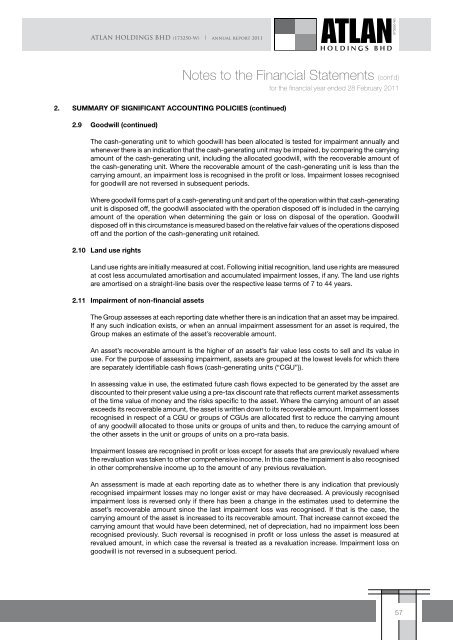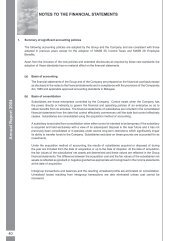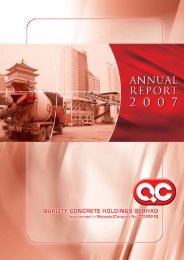ANNUAL REPORT LAPORAN TAHUNAN 2011 A TLAN HOLDINGS ...
ANNUAL REPORT LAPORAN TAHUNAN 2011 A TLAN HOLDINGS ...
ANNUAL REPORT LAPORAN TAHUNAN 2011 A TLAN HOLDINGS ...
You also want an ePaper? Increase the reach of your titles
YUMPU automatically turns print PDFs into web optimized ePapers that Google loves.
A<strong>TLAN</strong> <strong>HOLDINGS</strong> BHD (173250-W) I annual report <strong>2011</strong><br />
2. SUMMARY OF SIGNIFICANT ACCOUNTING POLICIES (continued)<br />
2.9 Goodwill (continued)<br />
Notes to the Financial Statements (cont’d)<br />
for the financial year ended 28 February <strong>2011</strong><br />
The cash-generating unit to which goodwill has been allocated is tested for impairment annually and<br />
whenever there is an indication that the cash-generating unit may be impaired, by comparing the carrying<br />
amount of the cash-generating unit, including the allocated goodwill, with the recoverable amount of<br />
the cash-generating unit. Where the recoverable amount of the cash-generating unit is less than the<br />
carrying amount, an impairment loss is recognised in the profit or loss. Impairment losses recognised<br />
for goodwill are not reversed in subsequent periods.<br />
Where goodwill forms part of a cash-generating unit and part of the operation within that cash-generating<br />
unit is disposed off, the goodwill associated with the operation disposed off is included in the carrying<br />
amount of the operation when determining the gain or loss on disposal of the operation. Goodwill<br />
disposed off in this circumstance is measured based on the relative fair values of the operations disposed<br />
off and the portion of the cash-generating unit retained.<br />
2.10 Land use rights<br />
Land use rights are initially measured at cost. Following initial recognition, land use rights are measured<br />
at cost less accumulated amortisation and accumulated impairment losses, if any. The land use rights<br />
are amortised on a straight-line basis over the respective lease terms of 7 to 44 years.<br />
2.11 Impairment of non-financial assets<br />
The Group assesses at each reporting date whether there is an indication that an asset may be impaired.<br />
If any such indication exists, or when an annual impairment assessment for an asset is required, the<br />
Group makes an estimate of the asset’s recoverable amount.<br />
An asset’s recoverable amount is the higher of an asset’s fair value less costs to sell and its value in<br />
use. For the purpose of assessing impairment, assets are grouped at the lowest levels for which there<br />
are separately identifiable cash flows (cash-generating units (“CGU”)).<br />
In assessing value in use, the estimated future cash flows expected to be generated by the asset are<br />
discounted to their present value using a pre-tax discount rate that reflects current market assessments<br />
of the time value of money and the risks specific to the asset. Where the carrying amount of an asset<br />
exceeds its recoverable amount, the asset is written down to its recoverable amount. Impairment losses<br />
recognised in respect of a CGU or groups of CGUs are allocated first to reduce the carrying amount<br />
of any goodwill allocated to those units or groups of units and then, to reduce the carrying amount of<br />
the other assets in the unit or groups of units on a pro-rata basis.<br />
Impairment losses are recognised in profit or loss except for assets that are previously revalued where<br />
the revaluation was taken to other comprehensive income. In this case the impairment is also recognised<br />
in other comprehensive income up to the amount of any previous revaluation.<br />
An assessment is made at each reporting date as to whether there is any indication that previously<br />
recognised impairment losses may no longer exist or may have decreased. A previously recognised<br />
impairment loss is reversed only if there has been a change in the estimates used to determine the<br />
asset’s recoverable amount since the last impairment loss was recognised. If that is the case, the<br />
carrying amount of the asset is increased to its recoverable amount. That increase cannot exceed the<br />
carrying amount that would have been determined, net of depreciation, had no impairment loss been<br />
recognised previously. Such reversal is recognised in profit or loss unless the asset is measured at<br />
revalued amount, in which case the reversal is treated as a revaluation increase. Impairment loss on<br />
goodwill is not reversed in a subsequent period.<br />
57










